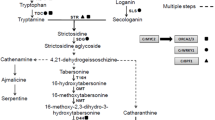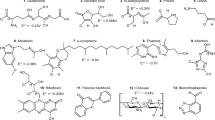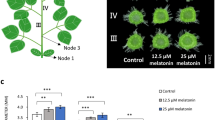Abstract
Taurine is a recently recognized plant growth regulator under abiotic stress. However, the information on taurine-mediated plant defense responses is scarce, particularly on taurine-mediated regulation of the glyoxalase system. There is currently no report available on the use of taurine as seed priming under stress. Chromium (Cr) toxicity considerably subsided growth characteristics, photosynthetic pigments, and relative water content. Furthermore, plants encountered intensified oxidative injury due to a significant increase in relative membrane permeability, H2O2, O2•‒, and MDA production. The amount of antioxidant compounds and the functioning of antioxidant enzymes rose, but imbalance due to over ROS generation frequently depleted antioxidant compounds. Taurine seed priming (50, 100, 150, and 200 mg L‒1) notably diminished oxidative injury, strengthened the antioxidant system, and conspicuously subsided methylglyoxal levels through enhanced activities of glyoxalase enzymes. The accumulation of Cr content was minimal in plants administered taurine as seed priming. In conclusion, our research demonstrates that taurine priming effectively mitigated the adverse effects of Cr toxicity on canola. Taurine reduced oxidative damage, leading to improved growth, enhanced chlorophyll levels, optimized ROS metabolism, and enhanced methylglyoxal detoxification. These findings highlight the potential of taurine as a promising strategy to enhance the tolerance of canola plants to Cr toxicity.







Similar content being viewed by others
Data availability
Not applicable.
References
Ahmad S, Mfarrej MFB, El-Esawi MA, Waseem M, Alatawi A, Nafees M, Saleem MH, Rizwan M, Yasmeen T, Anayat A, Ali S (2022) Chromium-resistant Staphylococcus aureus alleviates chromium toxicity by developing synergistic relationships with zinc oxide nanoparticles in wheat. Ecotoxicol Environ Saf 230:113142. https://doi.org/10.1016/j.ecoenv.2021.113142
Altaf MA, Hao Y, Shu H, Mumtaz MA, Cheng S, Alyemeni MN, Ahmad P, Wang Z (2023) Melatonin enhanced the heavy metal-stress tolerance of pepper by mitigating the oxidative damage and reducing the heavy metal accumulation. J Hazard Mate 454:131468
Ashraf MA, Rasheed R, Hussain I, Iqbal M, Farooq MU, Saleem MH, Ali S (2022) Taurine modulates dynamics of oxidative defense, secondary metabolism, and nutrient relation to mitigate boron and chromium toxicity in Triticum aestivum L. plants. Environ Sci Pollut Res 29(30):45527–45548. https://doi.org/10.1007/s11356-022-19066-5
Ashraf MA, Rasheed R, Rizwan M, Hussain I, Aslam R, Qureshi FF, Hafiza BS, Bashir R, Ali S (2023) Effect of exogenous taurine on pea (Pisum sativum L.) plants under salinity and iron deficiency stress. Environ Res 223:115448. https://doi.org/10.1016/j.envres.2023.115448
Ashraf MA, Rasheed R, Zafar S, Iqbal M, Saqib ZA (2021) Menadione sodium bisulfite neutralizes chromium phytotoxic effects in okra by regulating cytosolutes, lipid peroxidation, antioxidant system and metal uptake. Int J Phytoremediation 23(7):736–746. https://doi.org/10.1080/15226514.2020.1854171
Barrs H, Weatherley P (1962) A re-examination of the relative turgidity technique for estimating water deficits in leaves. Aust J Biol Sci 15(3):413–428
Basit F, Tao J, An J, Song X, Sheteiwy MS, Holford P, Hu J, Jośko I, Guan Y (2023) Nitric oxide and brassinosteroids enhance chromium stress tolerance in Glycine max L. (Merr.) by modulating antioxidative defense and glyoxalase systems. Environ Sci Pollut Res 30(18):51638–51653
Bates LS, Waldren RP, Teare ID (1973) Rapid determination of free proline for water-stress studies. Plant Soil 39(1):205–207. https://doi.org/10.1007/BF00018060
Bouyoucos GJ (1962) Hydrometer method improved for making particle size analyses of soils 1. Agron J 54(5):464–465
Cakmak I, Horst WJ (1991) Effect of aluminium on lipid peroxidation, superoxide dismutase, catalase, and peroxidase activities in root tips of soybean (Glycine max). Physiologia Plant 83(3):463–468. https://doi.org/10.1111/j.1399-3054.1991.tb00121.x
Chance B, Maehly AC (1955) [136] Assay of catalases and peroxidases. In: Methods in Enzymology, vol 2. Academic Press, pp 764–775. https://doi.org/10.1016/S0076-6879(55)02300-8
Doderer A, Kokkelink I, van der Veen S, Valk BE, Schram A, Douma AC (1992) Purification and characterization of two lipoxygenase isoenzymes from germinating barley. Biochimica et Biophysica Acta (BBA) - Protein Struct Mol Enzymol 1120(1):97–104. https://doi.org/10.1016/0167-4838(92)90429-H
Fu X, Mehmood S, Ahmed W, Ou W, Suo P, Zhang Q, Fu X, Sun Z, Li W (2023) Reducing chromium toxicity in Chinese cabbage through synergistic effects of silicon and selenium: a study of plant growth, chromium content, and biochemical parameters. Sustainability 15(6):5361
Gardner FP, Pearce RB, Mitchell RL (1985) Physiology of crop plants. Iowa State University Press, Ames, pp 187–208
Giannopolitis CN, Ries SK (1977) Superoxide dismutases: I. Occurrence in higher plants. Plant Physiol 59(2):309–314
Grieve CM, Grattan SR (1983) Rapid assay for determination of water soluble quaternary ammonium compounds. Plant Soil 70(2):303–307. https://doi.org/10.1007/BF02374789
Hafeez A, Rasheed R, Ashraf MA, Rizwan M, Ali S (2022) Effects of exogenous taurine on growth, photosynthesis, oxidative stress, antioxidant enzymes and nutrient accumulation by Trifolium alexandrinum plants under manganese stress. Chemosphere 308:136523. https://doi.org/10.1016/j.chemosphere.2022.136523
Hamilton PB, Van Slyke DD, Lemish S (1943) The gasometric determination of free amino acids in blood filtrates by the ninhydrin-carbon dioxide method. J Biol Chem 150:231–250
Hasanuzzaman M, Hossain MA, Fujita M (2011) Nitric oxide modulates antioxidant defense and the methylglyoxal detoxification system and reduces salinity-induced damage of wheat seedlings. Plant Biotechnol Rep 5(4):353. https://doi.org/10.1007/s11816-011-0189-9
Jamil N, Hyder S, Valipour M, Yasir M, Iqbal R, Roy R, Zafar MU, Ahmed A (2022) Evaluation of the bioremediation potential of Staphlococcus lentus inoculations of plants as a promising strategy used to attenuate chromium toxicity. Sustainability 14(20):13056
Jensen A (1978) Chlorophylls and carotenoids. In: Hellebust JA, Craigie JS (eds) Handbook of phycological methods, physiological and biochemical methods. Cambridge University Press, Cambridge, pp 59–70
Joyia FA, Ashraf MY, Shafiq F, Anwar S, Nisa Z-u, Khaliq B, Malik A (2021) Phytotoxic effects of varying concentrations of leather tannery effluents on cotton and brinjal. Agric Water Manag 246:10670. https://doi.org/10.1016/j.agwat.2020.106707
Kaya C, Akram NA, Sürücü A, Ashraf M (2019) Alleviating effect of nitric oxide on oxidative stress and antioxidant defence system in pepper (Capsicum annuum L.) plants exposed to cadmium and lead toxicity applied separately or in combination. Sci Hortic 255:52–60. https://doi.org/10.1016/j.scienta.2019.05.029
Kumar P, Tokas J, Singal HR (2019) Amelioration of chromium vi toxicity in sorghum (Sorghum bicolor L.) using glycine betaine. Sci Rep 9(1):16020. https://doi.org/10.1038/s41598-019-52479-w
Kumar S, Wang M, Fahad S, Qayyum A, Chen Y, Zhu G (2022) Chromium induces toxicity at different phenotypic, physiological, biochemical, and ultrastructural levels in Sweet potato (Ipomoea batatas L.) plants. Int J Mol Sci 23(21):13496
Lichtenthaler HK (1987) [34] Chlorophylls and carotenoids: pigments of photosynthetic biomembranes. In: Methods in Enzymology, vol 148. Academic Press, pp 350–382. https://doi.org/10.1016/0076-6879(87)48036-1
Loomis WE, Shull CA (1937) Methods in plant physiology. McGraw Hill Book Co., New York
Ma J, Alshaya H, Okla MK, Alwasel YA, Chen F, Adrees M, Hussain A, Hameed S, Shahid MJ (2022) Application of cerium dioxide nanoparticles and chromium-resistant bacteria reduced chromium toxicity in sunflower plants. Front Plant Sci 13:876119. https://doi.org/10.3389/fpls.2022.876119
Mahmud JA, Hasanuzzaman M, Nahar K, Bhuyan MHMB, Fujita M (2018) Insights into citric acid-induced cadmium tolerance and phytoremediation in Brassica juncea L.: Coordinated functions of metal chelation, antioxidant defense and glyoxalase systems. Ecotoxicol Environ Saf 147:990–1001. https://doi.org/10.1016/j.ecoenv.2017.09.045
Mita S, Murano N, Akaike M, Nakamura K (1997) Mutants of Arabidopsis thaliana with pleiotropic effects on the expression of the gene for β-amylase and on the accumulation of anthocyanin that are inducible by sugars. Plant J 11(4):841–851. https://doi.org/10.1046/j.1365-313X.1997.11040841.x
Nahar K, Hasanuzzaman M, Alam MM, Rahman A, Suzuki T, Fujita M (2016) Polyamine and nitric oxide crosstalk: antagonistic effects on cadmium toxicity in mung bean plants through upregulating the metal detoxification, antioxidant defense and methylglyoxal detoxification systems. Ecotoxicol Environ Saf 126:245–255. https://doi.org/10.1016/j.ecoenv.2015.12.026
Nashef AS, Osuga DT, Feeney RE (1977) Determination of hydrogen sulfide with 5,5′-dithiobis-(2-nitrobenzoic acid), N-ethylmaleimide, and parachloromercuribenzoate. Anal Biochem 79(1):394–405. https://doi.org/10.1016/0003-2697(77)90413-4
Nelson N (1944) A photometric adaptation of the Somogyi method for the determination of glucose. J Biol Chem 153(2):375–380
Nikolaou K-E, Chatzistathis T, Theocharis S, Argiriou A, Koundouras S, Zioziou E (2022) Effects of chromium toxicity on physiological performance and nutrient uptake in two grapevine cultivars (Vitis vinifera L.) growing on own roots or grafted onto different rootstocks. Horticulturae 8(6):493
Noor I, Sohail H, Hasanuzzaman M, Hussain S, Li G, Liu J (2022) Phosphorus confers tolerance against manganese toxicity in Prunus persica by reducing oxidative stress and improving chloroplast ultrastructure. Chemosphere 291:132999. https://doi.org/10.1016/j.chemosphere.2021.132999
Okant M, Kaya C (2019) The role of endogenous nitric oxide in melatonin-improved tolerance to lead toxicity in maize plants. Environ Sci Pollut Res 26(12):11864–11874. https://doi.org/10.1007/s11356-019-04517-3
Parvin K, Hasanuzzaman M, Mohsin SM, Nahar K, Fujita M (2021) Coumarin improves tomato plant tolerance to salinity by enhancing antioxidant defence, glyoxalase system and ion homeostasis. Plant Biol 23(S1):181–192. https://doi.org/10.1111/plb.13208
Polle A, Otter T, Seifert F (1994) Apoplastic peroxidases and lignification in needles of Norway spruce (Picea abies L.). Plant Physiol 106(1):53–60
Qureshi FF, Ashraf MA, Rasheed R, Ali S, Hussain I, Ahmed A, Iqbal M (2020) Organic chelates decrease phytotoxic effects and enhance chromium uptake by regulating chromium-speciation in castor bean (Ricinus communis L.). Sci Total Environ 716:137061. https://doi.org/10.1016/j.scitotenv.2020.137061
Sarker U, Oba S (2018) Response of nutrients, minerals, antioxidant leaf pigments, vitamins, polyphenol, flavonoid and antioxidant activity in selected vegetable amaranth under four soil water content. Food Chem 252:72–83. https://doi.org/10.1016/j.foodchem.2018.01.097
Seleiman MF, Ali S, Refay Y, Rizwan M, Alhammad BA, El-Hendawy SE (2020) Chromium resistant microbes and melatonin reduced Cr uptake and toxicity, improved physio-biochemical traits and yield of wheat in contaminated soil. Chemosphere 250:126239. https://doi.org/10.1016/j.chemosphere.2020.126239
Shad MI, Ashraf MA, Rasheed R, Hussain I, Ali S (2022) Exogenous coumarin decreases phytotoxic effects of manganese by regulating ascorbate–glutathione cycle and glyoxalase system to improve photosynthesis and nutrient acquisition in sesame (Sesamum indicum L). J Soil Sci Plant Nutr. https://doi.org/10.1007/s42729-022-00983-w
Sharma P, Singh SP, Tripathi RD, Tong YW (2023) Chromium toxicity and tolerance mechanisms in plants through cross-talk of secondary messengers: an overview of pathways and mechanisms. Environ Pollut 320:121049
Soni SK, Kumar G, Bajpai A, Singh R, Bajapi Y, Laxmi Tiwari S (2023) Hexavalent chromium-reducing plant growth-promoting rhizobacteria are utilized to bio-fortify trivalent chromium in fenugreek by promoting plant development and decreasing the toxicity of hexavalent chromium in the soil. J Trace Elem Med Biol 76:127116. https://doi.org/10.1016/j.jtemb.2022.127116
Velikova V, Yordanov I, Edreva A (2000) Oxidative stress and some antioxidant systems in acid rain-treated bean plants: protective role of exogenous polyamines. Plant Sci 151(1):59–66. https://doi.org/10.1016/S0168-9452(99)00197-1
Walkley A, Black IA (1934) An examination of the Degtjareff method for determining soil organic matter, and a proposed modification of the chromic acid titration method. Soil Sci 37(1):29–38
Wolfe K, Wu X, Liu RH (2003) Antioxidant activity of apple peels. J Agric Food Chem 51(3):609–614
Yang G, Rhodes D, Joly R (1996) Effects of high temperature on membrane stability and chlorophyll fluorescence in glycinebetaine-deficient and glycinebetaine-containing maize lines. Funct Plant Biol 23(4):437–443. https://doi.org/10.1071/PP9960437
Yang H, Shi G, Qiao X, Tian X (2011) Exogenous spermidine and spermine enhance cadmium tolerance of Potamogeton malaianus. Russ J Plant Physiol 58(4)
Yang X, Ren J, Lin X, Yang Z, Deng X, Ke Q (2023) Melatonin alleviates chromium toxicity in maize by modulation of cell wall polysaccharides biosynthesis, glutathione metabolism, and antioxidant capacity. Int J Mol Sci 24(4):3816
Yemm E, Willis A (1954) The estimation of carbohydrates in plant extracts by anthrone. Biochem J 57(3):508
Zhishen J, Mengcheng T, Jianming W (1999) The determination of flavonoid contents in mulberry and their scavenging effects on superoxide radicals. Food Chem 64(4):555–559. https://doi.org/10.1016/S0308-8146(98)00102-2
Funding
This work was supported by Researchers Supporting Project number (RSP2023R100), King Saud University, Riyadh, Saudi Arabia.
Author information
Authors and Affiliations
Contributions
MA Ashraf conceived and designed the experiment; SM Ibrahim assisted in software and statistical analyses of data; Hussain I. and Rasheed R performed the experiment; MA Ashraf wrote the manuscript; M. Rizwan contributed to reagents/analysis/materials; S Ali assisted in review, editing, and software use for graphical representation of data.
Corresponding author
Ethics declarations
Ethical approval
Not applicable.
Consent to participate
Not applicable.
Consent for publication
Not applicable.
Conflict of interest
The authors declare no competing interests.
Additional information
Responsible Editor: Gangrong Shi
Publisher's note
Springer Nature remains neutral with regard to jurisdictional claims in published maps and institutional affiliations.
Rights and permissions
Springer Nature or its licensor (e.g. a society or other partner) holds exclusive rights to this article under a publishing agreement with the author(s) or other rightsholder(s); author self-archiving of the accepted manuscript version of this article is solely governed by the terms of such publishing agreement and applicable law.
About this article
Cite this article
Ashraf, M.A., Ibrahim, S.M., Rasheed, R. et al. Effect of seed priming by taurine on growth and chromium (Cr) uptake in canola (Brassica napus L.) under Cr stress. Environ Sci Pollut Res 30, 87851–87865 (2023). https://doi.org/10.1007/s11356-023-28471-3
Received:
Accepted:
Published:
Issue Date:
DOI: https://doi.org/10.1007/s11356-023-28471-3




